Water and Energy Sustainability in Australia and Japan Report
VerifiedAdded on 2020/03/16
|10
|2005
|29
Report
AI Summary
This report provides a comparative analysis of water and energy sustainability in Australia and Japan. It examines government regulations, technological innovations, and the roles of NGOs and the private sector in both countries. The report details specific acts, such as the Central Coast Water Corporation Act in Australia and the Waterworks Act in Japan, as well as key technological advancements like membrane bioreactor technology and water-saving technologies. It also explores exemplar practices, including water loss management projects and energy efficiency programs. The report highlights the differences in approach due to each country's unique geography and industrial pressures, while also acknowledging Japan's technological lead. The conclusion emphasizes the global need for sustainability and the importance of learning from the strategies of Australia and Japan.
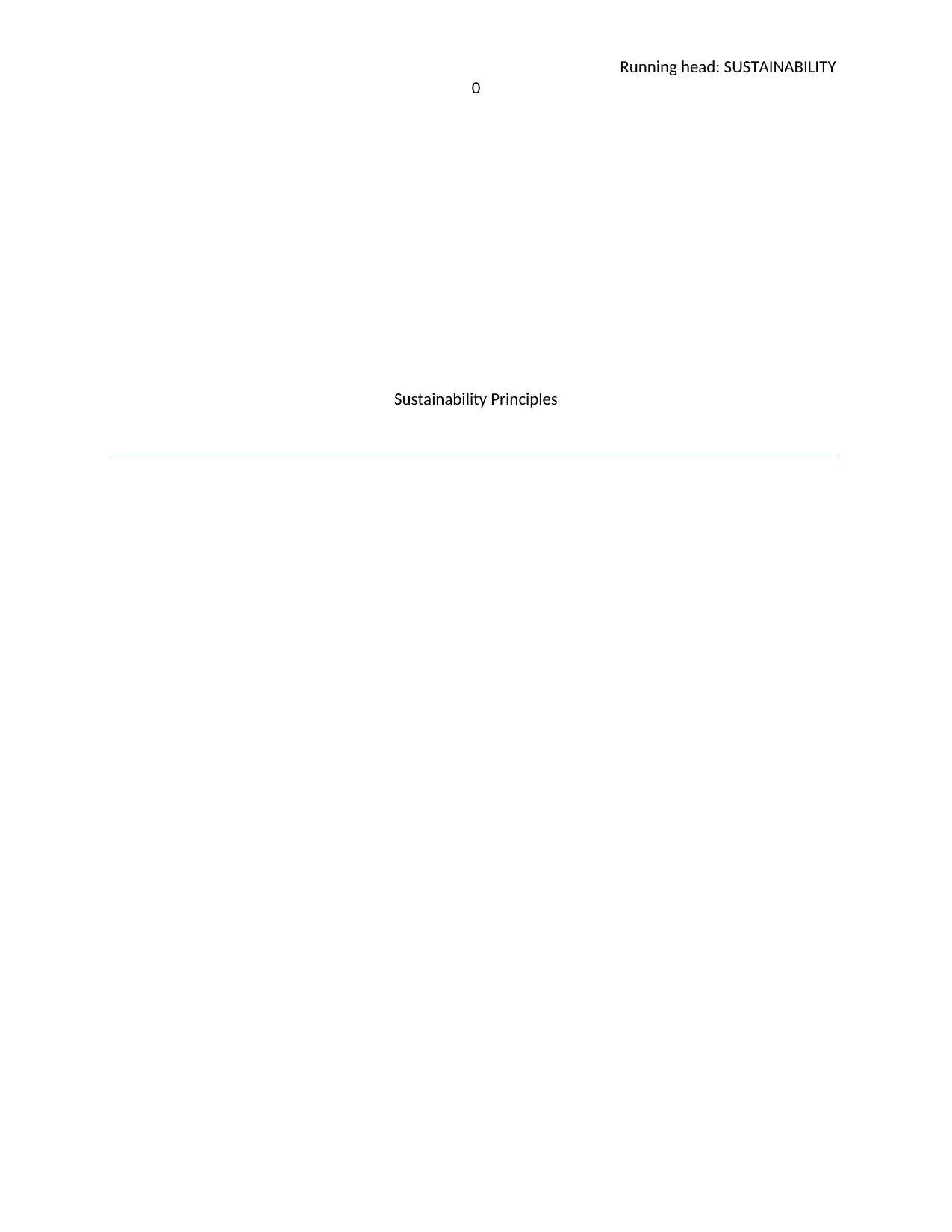
Running head: SUSTAINABILITY
0
Sustainability Principles
0
Sustainability Principles
Paraphrase This Document
Need a fresh take? Get an instant paraphrase of this document with our AI Paraphraser
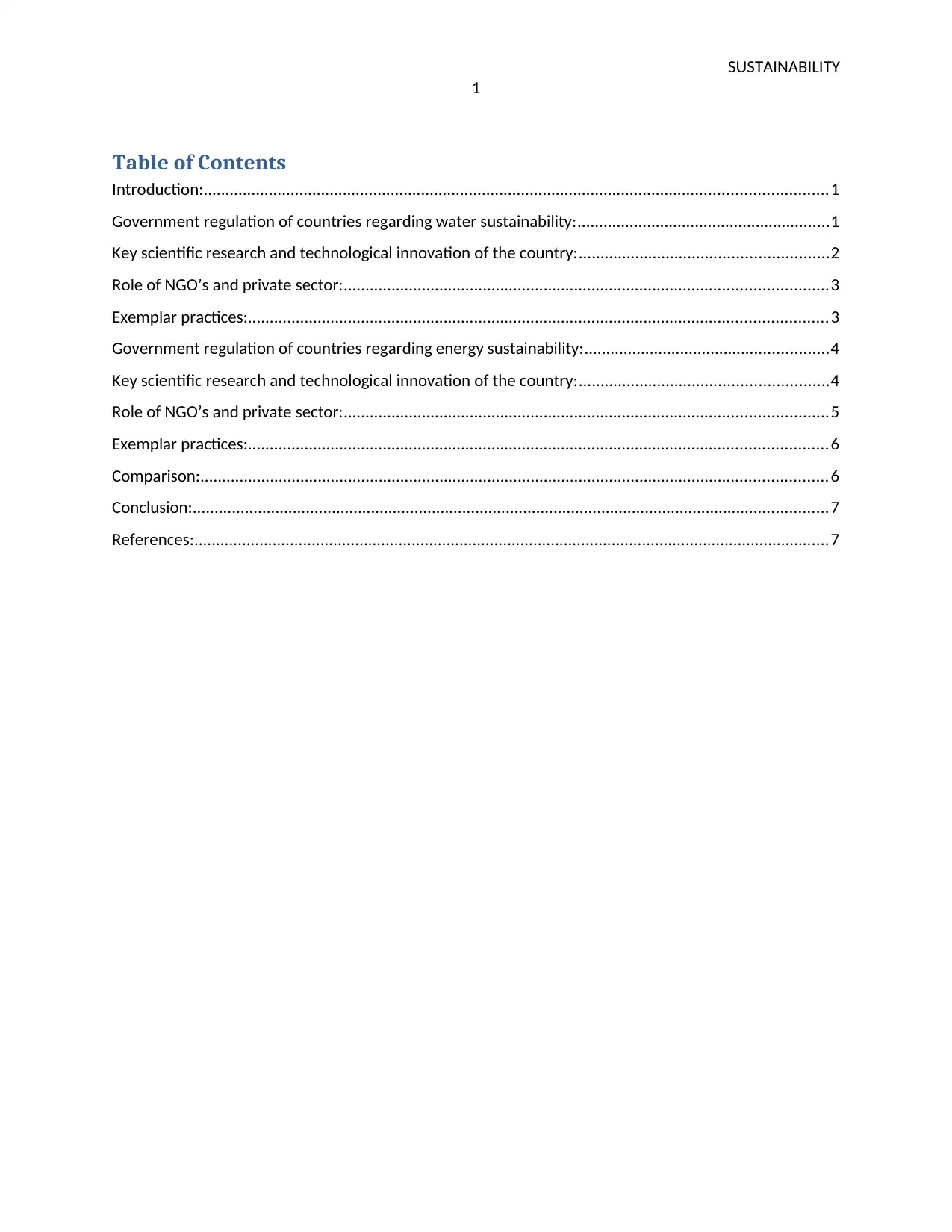
SUSTAINABILITY
1
Table of Contents
Introduction:...............................................................................................................................................1
Government regulation of countries regarding water sustainability:..........................................................1
Key scientific research and technological innovation of the country:.........................................................2
Role of NGO’s and private sector:...............................................................................................................3
Exemplar practices:.....................................................................................................................................3
Government regulation of countries regarding energy sustainability:........................................................4
Key scientific research and technological innovation of the country:.........................................................4
Role of NGO’s and private sector:...............................................................................................................5
Exemplar practices:.....................................................................................................................................6
Comparison:................................................................................................................................................6
Conclusion:..................................................................................................................................................7
References:..................................................................................................................................................7
1
Table of Contents
Introduction:...............................................................................................................................................1
Government regulation of countries regarding water sustainability:..........................................................1
Key scientific research and technological innovation of the country:.........................................................2
Role of NGO’s and private sector:...............................................................................................................3
Exemplar practices:.....................................................................................................................................3
Government regulation of countries regarding energy sustainability:........................................................4
Key scientific research and technological innovation of the country:.........................................................4
Role of NGO’s and private sector:...............................................................................................................5
Exemplar practices:.....................................................................................................................................6
Comparison:................................................................................................................................................6
Conclusion:..................................................................................................................................................7
References:..................................................................................................................................................7
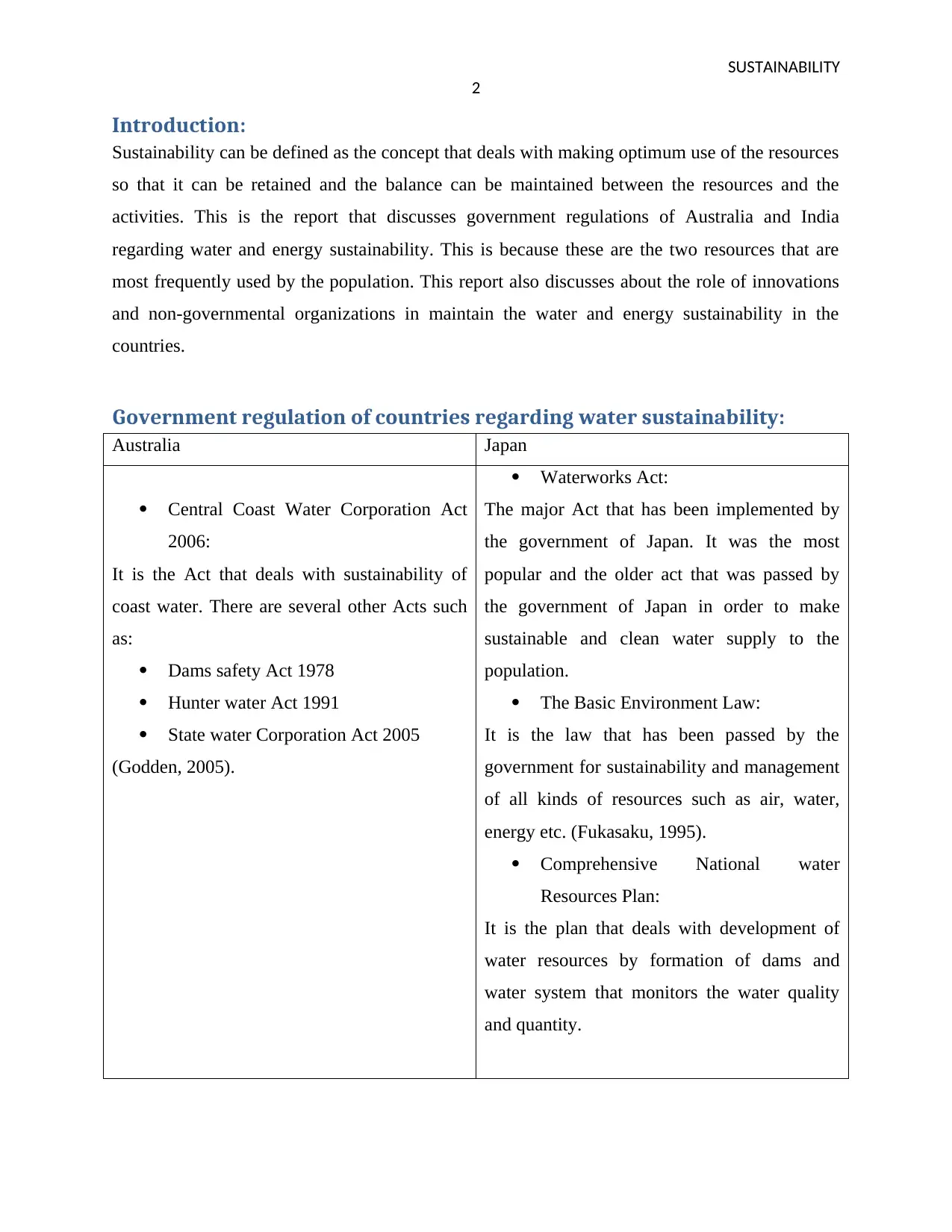
SUSTAINABILITY
2
Introduction:
Sustainability can be defined as the concept that deals with making optimum use of the resources
so that it can be retained and the balance can be maintained between the resources and the
activities. This is the report that discusses government regulations of Australia and India
regarding water and energy sustainability. This is because these are the two resources that are
most frequently used by the population. This report also discusses about the role of innovations
and non-governmental organizations in maintain the water and energy sustainability in the
countries.
Government regulation of countries regarding water sustainability:
Australia Japan
Central Coast Water Corporation Act
2006:
It is the Act that deals with sustainability of
coast water. There are several other Acts such
as:
Dams safety Act 1978
Hunter water Act 1991
State water Corporation Act 2005
(Godden, 2005).
Waterworks Act:
The major Act that has been implemented by
the government of Japan. It was the most
popular and the older act that was passed by
the government of Japan in order to make
sustainable and clean water supply to the
population.
The Basic Environment Law:
It is the law that has been passed by the
government for sustainability and management
of all kinds of resources such as air, water,
energy etc. (Fukasaku, 1995).
Comprehensive National water
Resources Plan:
It is the plan that deals with development of
water resources by formation of dams and
water system that monitors the water quality
and quantity.
2
Introduction:
Sustainability can be defined as the concept that deals with making optimum use of the resources
so that it can be retained and the balance can be maintained between the resources and the
activities. This is the report that discusses government regulations of Australia and India
regarding water and energy sustainability. This is because these are the two resources that are
most frequently used by the population. This report also discusses about the role of innovations
and non-governmental organizations in maintain the water and energy sustainability in the
countries.
Government regulation of countries regarding water sustainability:
Australia Japan
Central Coast Water Corporation Act
2006:
It is the Act that deals with sustainability of
coast water. There are several other Acts such
as:
Dams safety Act 1978
Hunter water Act 1991
State water Corporation Act 2005
(Godden, 2005).
Waterworks Act:
The major Act that has been implemented by
the government of Japan. It was the most
popular and the older act that was passed by
the government of Japan in order to make
sustainable and clean water supply to the
population.
The Basic Environment Law:
It is the law that has been passed by the
government for sustainability and management
of all kinds of resources such as air, water,
energy etc. (Fukasaku, 1995).
Comprehensive National water
Resources Plan:
It is the plan that deals with development of
water resources by formation of dams and
water system that monitors the water quality
and quantity.
⊘ This is a preview!⊘
Do you want full access?
Subscribe today to unlock all pages.

Trusted by 1+ million students worldwide
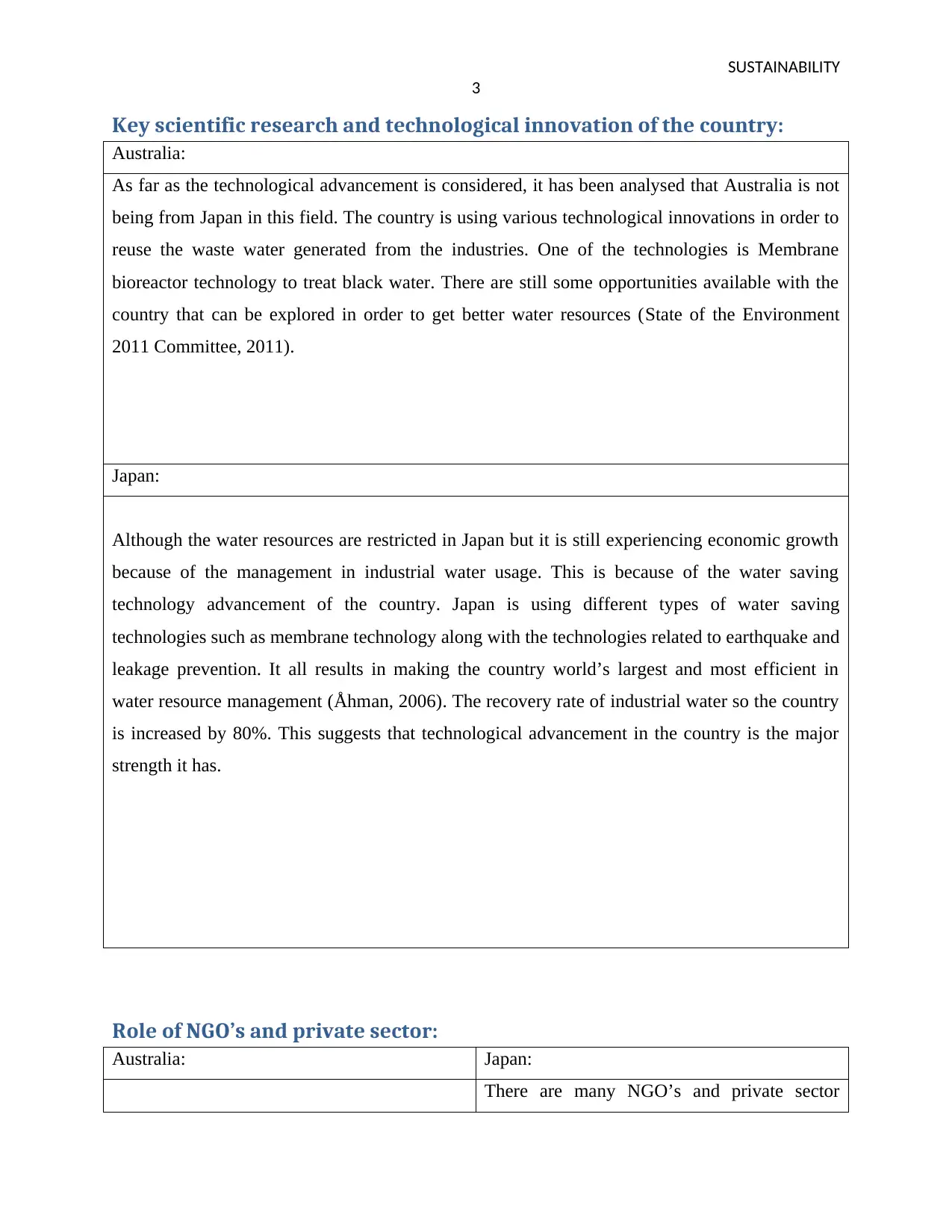
SUSTAINABILITY
3
Key scientific research and technological innovation of the country:
Australia:
As far as the technological advancement is considered, it has been analysed that Australia is not
being from Japan in this field. The country is using various technological innovations in order to
reuse the waste water generated from the industries. One of the technologies is Membrane
bioreactor technology to treat black water. There are still some opportunities available with the
country that can be explored in order to get better water resources (State of the Environment
2011 Committee, 2011).
Japan:
Although the water resources are restricted in Japan but it is still experiencing economic growth
because of the management in industrial water usage. This is because of the water saving
technology advancement of the country. Japan is using different types of water saving
technologies such as membrane technology along with the technologies related to earthquake and
leakage prevention. It all results in making the country world’s largest and most efficient in
water resource management (Åhman, 2006). The recovery rate of industrial water so the country
is increased by 80%. This suggests that technological advancement in the country is the major
strength it has.
Role of NGO’s and private sector:
Australia: Japan:
There are many NGO’s and private sector
3
Key scientific research and technological innovation of the country:
Australia:
As far as the technological advancement is considered, it has been analysed that Australia is not
being from Japan in this field. The country is using various technological innovations in order to
reuse the waste water generated from the industries. One of the technologies is Membrane
bioreactor technology to treat black water. There are still some opportunities available with the
country that can be explored in order to get better water resources (State of the Environment
2011 Committee, 2011).
Japan:
Although the water resources are restricted in Japan but it is still experiencing economic growth
because of the management in industrial water usage. This is because of the water saving
technology advancement of the country. Japan is using different types of water saving
technologies such as membrane technology along with the technologies related to earthquake and
leakage prevention. It all results in making the country world’s largest and most efficient in
water resource management (Åhman, 2006). The recovery rate of industrial water so the country
is increased by 80%. This suggests that technological advancement in the country is the major
strength it has.
Role of NGO’s and private sector:
Australia: Japan:
There are many NGO’s and private sector
Paraphrase This Document
Need a fresh take? Get an instant paraphrase of this document with our AI Paraphraser
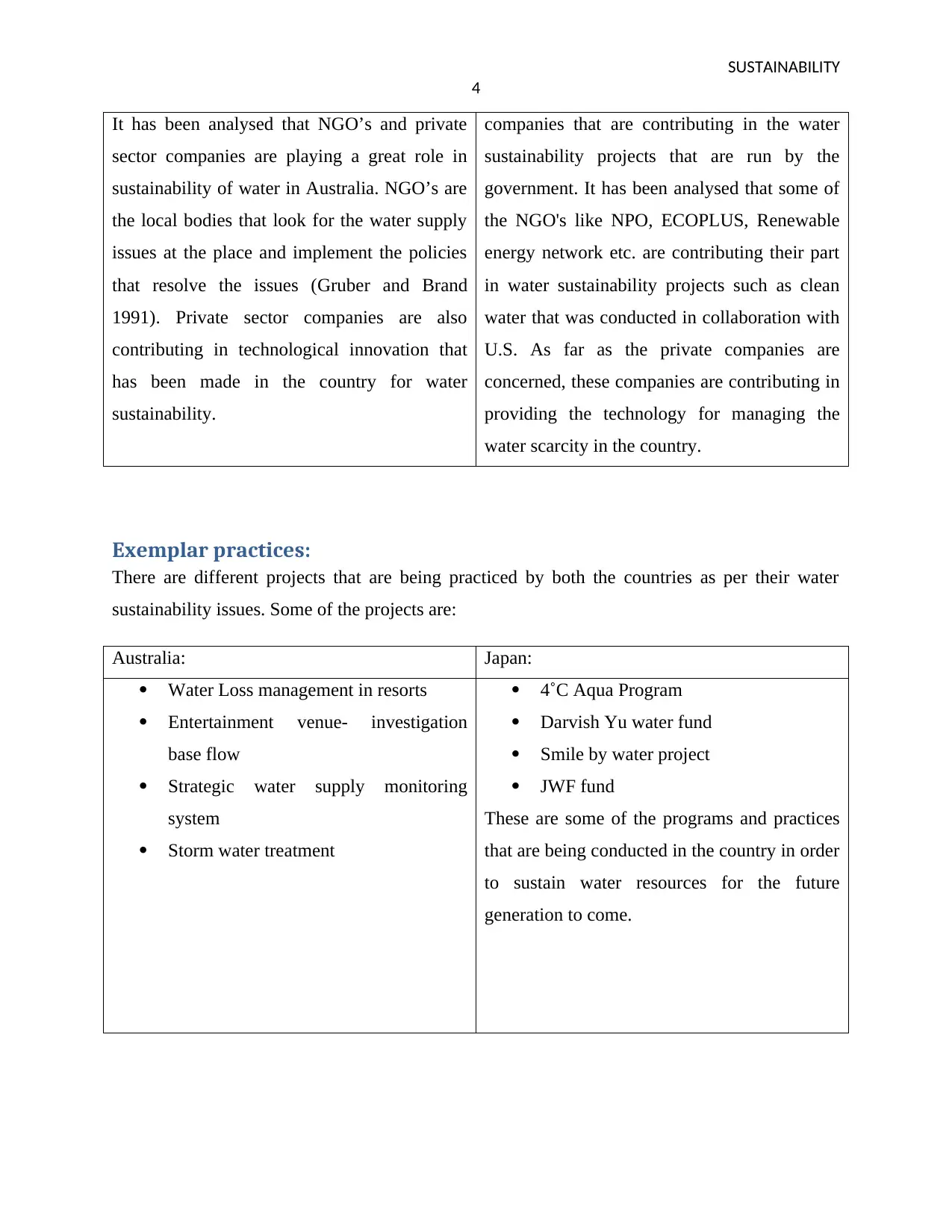
SUSTAINABILITY
4
It has been analysed that NGO’s and private
sector companies are playing a great role in
sustainability of water in Australia. NGO’s are
the local bodies that look for the water supply
issues at the place and implement the policies
that resolve the issues (Gruber and Brand
1991). Private sector companies are also
contributing in technological innovation that
has been made in the country for water
sustainability.
companies that are contributing in the water
sustainability projects that are run by the
government. It has been analysed that some of
the NGO's like NPO, ECOPLUS, Renewable
energy network etc. are contributing their part
in water sustainability projects such as clean
water that was conducted in collaboration with
U.S. As far as the private companies are
concerned, these companies are contributing in
providing the technology for managing the
water scarcity in the country.
Exemplar practices:
There are different projects that are being practiced by both the countries as per their water
sustainability issues. Some of the projects are:
Australia: Japan:
Water Loss management in resorts
Entertainment venue- investigation
base flow
Strategic water supply monitoring
system
Storm water treatment
4˚C Aqua Program
Darvish Yu water fund
Smile by water project
JWF fund
These are some of the programs and practices
that are being conducted in the country in order
to sustain water resources for the future
generation to come.
4
It has been analysed that NGO’s and private
sector companies are playing a great role in
sustainability of water in Australia. NGO’s are
the local bodies that look for the water supply
issues at the place and implement the policies
that resolve the issues (Gruber and Brand
1991). Private sector companies are also
contributing in technological innovation that
has been made in the country for water
sustainability.
companies that are contributing in the water
sustainability projects that are run by the
government. It has been analysed that some of
the NGO's like NPO, ECOPLUS, Renewable
energy network etc. are contributing their part
in water sustainability projects such as clean
water that was conducted in collaboration with
U.S. As far as the private companies are
concerned, these companies are contributing in
providing the technology for managing the
water scarcity in the country.
Exemplar practices:
There are different projects that are being practiced by both the countries as per their water
sustainability issues. Some of the projects are:
Australia: Japan:
Water Loss management in resorts
Entertainment venue- investigation
base flow
Strategic water supply monitoring
system
Storm water treatment
4˚C Aqua Program
Darvish Yu water fund
Smile by water project
JWF fund
These are some of the programs and practices
that are being conducted in the country in order
to sustain water resources for the future
generation to come.
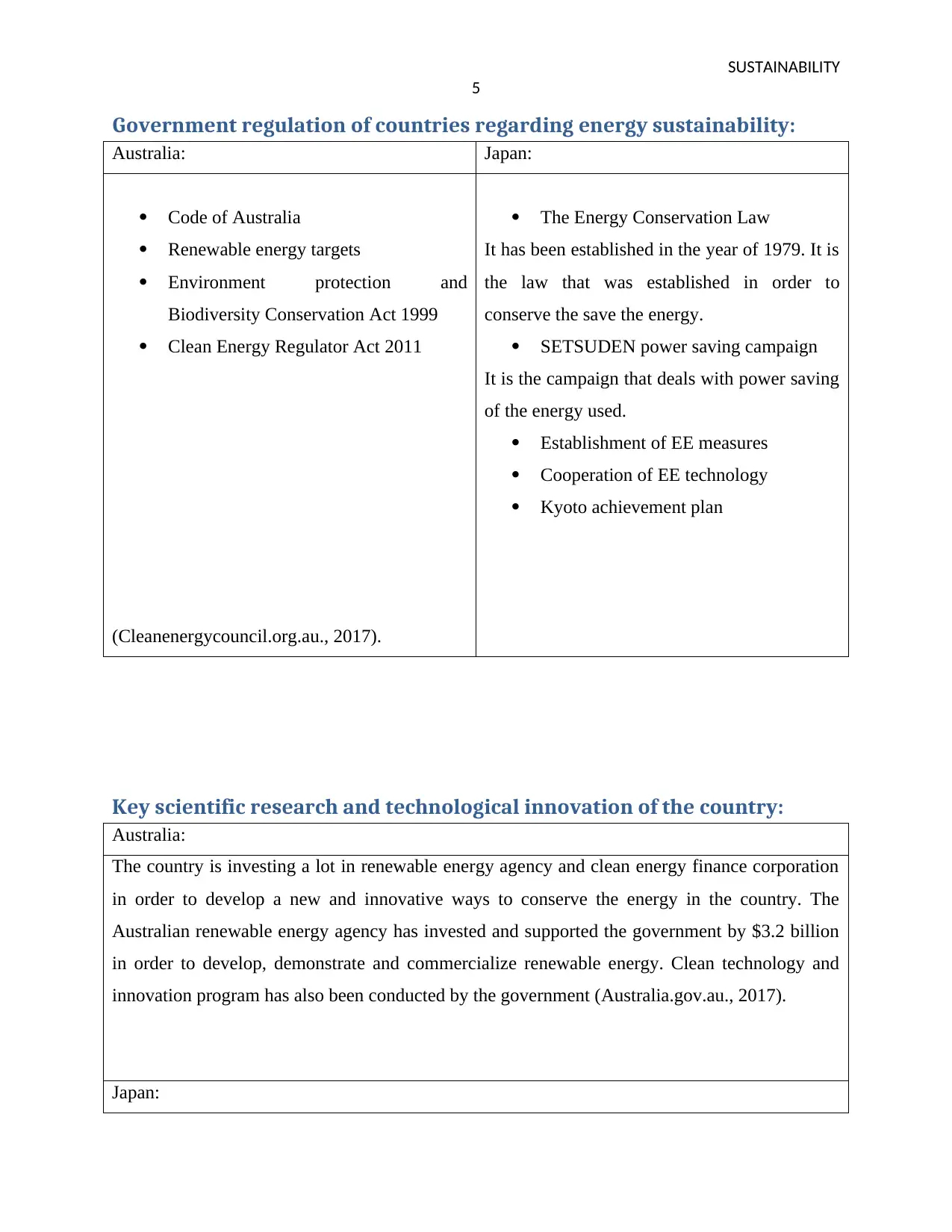
SUSTAINABILITY
5
Government regulation of countries regarding energy sustainability:
Australia: Japan:
Code of Australia
Renewable energy targets
Environment protection and
Biodiversity Conservation Act 1999
Clean Energy Regulator Act 2011
(Cleanenergycouncil.org.au., 2017).
The Energy Conservation Law
It has been established in the year of 1979. It is
the law that was established in order to
conserve the save the energy.
SETSUDEN power saving campaign
It is the campaign that deals with power saving
of the energy used.
Establishment of EE measures
Cooperation of EE technology
Kyoto achievement plan
Key scientific research and technological innovation of the country:
Australia:
The country is investing a lot in renewable energy agency and clean energy finance corporation
in order to develop a new and innovative ways to conserve the energy in the country. The
Australian renewable energy agency has invested and supported the government by $3.2 billion
in order to develop, demonstrate and commercialize renewable energy. Clean technology and
innovation program has also been conducted by the government (Australia.gov.au., 2017).
Japan:
5
Government regulation of countries regarding energy sustainability:
Australia: Japan:
Code of Australia
Renewable energy targets
Environment protection and
Biodiversity Conservation Act 1999
Clean Energy Regulator Act 2011
(Cleanenergycouncil.org.au., 2017).
The Energy Conservation Law
It has been established in the year of 1979. It is
the law that was established in order to
conserve the save the energy.
SETSUDEN power saving campaign
It is the campaign that deals with power saving
of the energy used.
Establishment of EE measures
Cooperation of EE technology
Kyoto achievement plan
Key scientific research and technological innovation of the country:
Australia:
The country is investing a lot in renewable energy agency and clean energy finance corporation
in order to develop a new and innovative ways to conserve the energy in the country. The
Australian renewable energy agency has invested and supported the government by $3.2 billion
in order to develop, demonstrate and commercialize renewable energy. Clean technology and
innovation program has also been conducted by the government (Australia.gov.au., 2017).
Japan:
⊘ This is a preview!⊘
Do you want full access?
Subscribe today to unlock all pages.

Trusted by 1+ million students worldwide
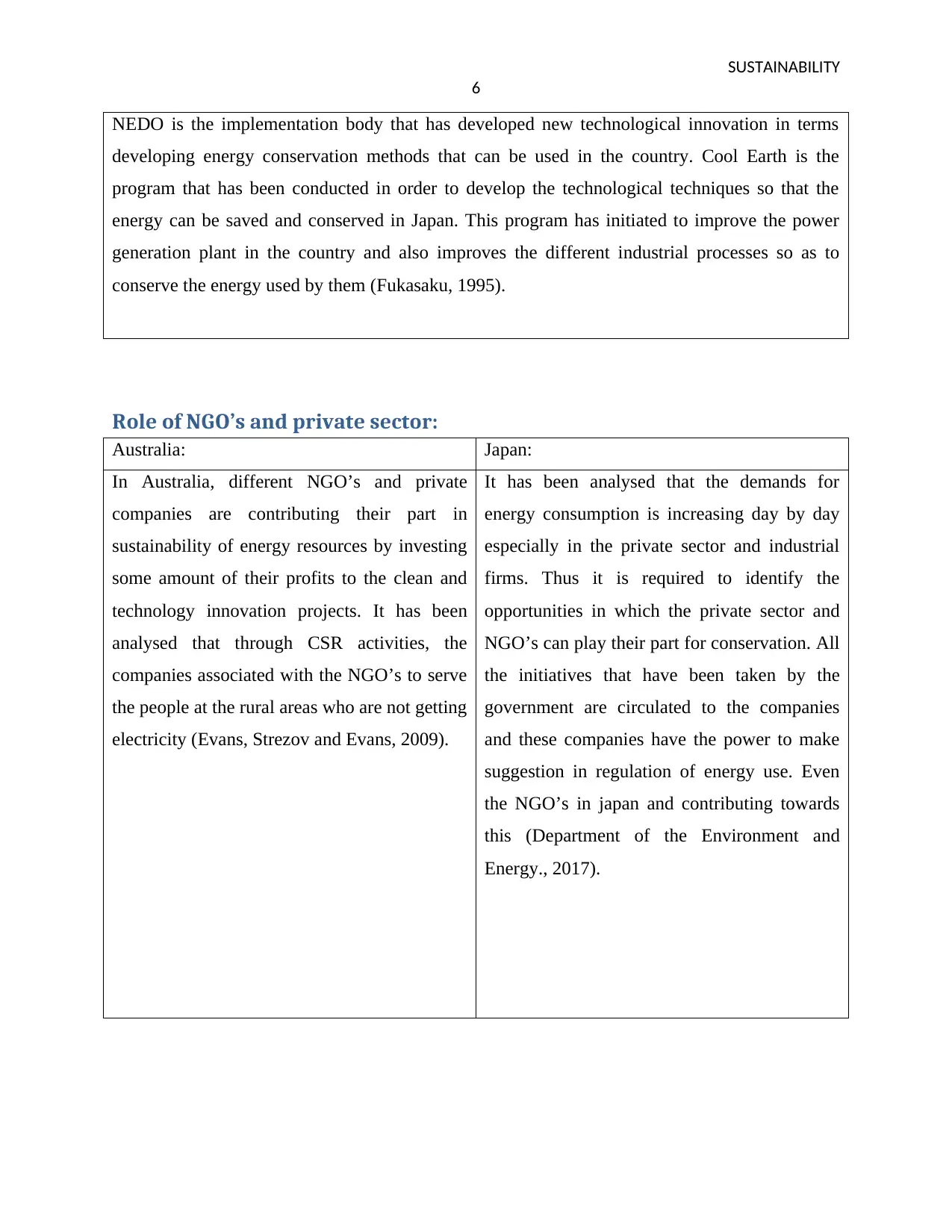
SUSTAINABILITY
6
NEDO is the implementation body that has developed new technological innovation in terms
developing energy conservation methods that can be used in the country. Cool Earth is the
program that has been conducted in order to develop the technological techniques so that the
energy can be saved and conserved in Japan. This program has initiated to improve the power
generation plant in the country and also improves the different industrial processes so as to
conserve the energy used by them (Fukasaku, 1995).
Role of NGO’s and private sector:
Australia: Japan:
In Australia, different NGO’s and private
companies are contributing their part in
sustainability of energy resources by investing
some amount of their profits to the clean and
technology innovation projects. It has been
analysed that through CSR activities, the
companies associated with the NGO’s to serve
the people at the rural areas who are not getting
electricity (Evans, Strezov and Evans, 2009).
It has been analysed that the demands for
energy consumption is increasing day by day
especially in the private sector and industrial
firms. Thus it is required to identify the
opportunities in which the private sector and
NGO’s can play their part for conservation. All
the initiatives that have been taken by the
government are circulated to the companies
and these companies have the power to make
suggestion in regulation of energy use. Even
the NGO’s in japan and contributing towards
this (Department of the Environment and
Energy., 2017).
6
NEDO is the implementation body that has developed new technological innovation in terms
developing energy conservation methods that can be used in the country. Cool Earth is the
program that has been conducted in order to develop the technological techniques so that the
energy can be saved and conserved in Japan. This program has initiated to improve the power
generation plant in the country and also improves the different industrial processes so as to
conserve the energy used by them (Fukasaku, 1995).
Role of NGO’s and private sector:
Australia: Japan:
In Australia, different NGO’s and private
companies are contributing their part in
sustainability of energy resources by investing
some amount of their profits to the clean and
technology innovation projects. It has been
analysed that through CSR activities, the
companies associated with the NGO’s to serve
the people at the rural areas who are not getting
electricity (Evans, Strezov and Evans, 2009).
It has been analysed that the demands for
energy consumption is increasing day by day
especially in the private sector and industrial
firms. Thus it is required to identify the
opportunities in which the private sector and
NGO’s can play their part for conservation. All
the initiatives that have been taken by the
government are circulated to the companies
and these companies have the power to make
suggestion in regulation of energy use. Even
the NGO’s in japan and contributing towards
this (Department of the Environment and
Energy., 2017).
Paraphrase This Document
Need a fresh take? Get an instant paraphrase of this document with our AI Paraphraser
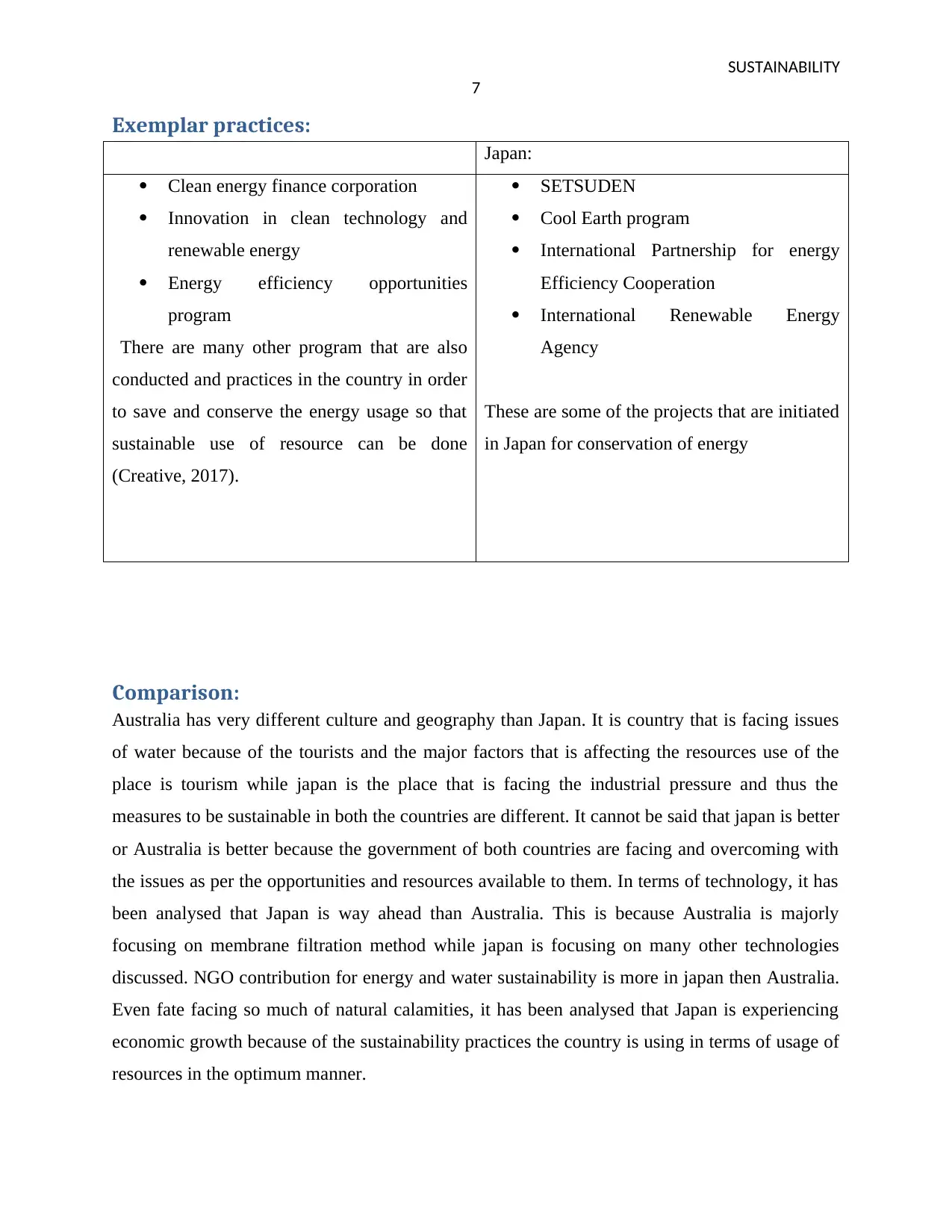
SUSTAINABILITY
7
Exemplar practices:
Japan:
Clean energy finance corporation
Innovation in clean technology and
renewable energy
Energy efficiency opportunities
program
There are many other program that are also
conducted and practices in the country in order
to save and conserve the energy usage so that
sustainable use of resource can be done
(Creative, 2017).
SETSUDEN
Cool Earth program
International Partnership for energy
Efficiency Cooperation
International Renewable Energy
Agency
These are some of the projects that are initiated
in Japan for conservation of energy
Comparison:
Australia has very different culture and geography than Japan. It is country that is facing issues
of water because of the tourists and the major factors that is affecting the resources use of the
place is tourism while japan is the place that is facing the industrial pressure and thus the
measures to be sustainable in both the countries are different. It cannot be said that japan is better
or Australia is better because the government of both countries are facing and overcoming with
the issues as per the opportunities and resources available to them. In terms of technology, it has
been analysed that Japan is way ahead than Australia. This is because Australia is majorly
focusing on membrane filtration method while japan is focusing on many other technologies
discussed. NGO contribution for energy and water sustainability is more in japan then Australia.
Even fate facing so much of natural calamities, it has been analysed that Japan is experiencing
economic growth because of the sustainability practices the country is using in terms of usage of
resources in the optimum manner.
7
Exemplar practices:
Japan:
Clean energy finance corporation
Innovation in clean technology and
renewable energy
Energy efficiency opportunities
program
There are many other program that are also
conducted and practices in the country in order
to save and conserve the energy usage so that
sustainable use of resource can be done
(Creative, 2017).
SETSUDEN
Cool Earth program
International Partnership for energy
Efficiency Cooperation
International Renewable Energy
Agency
These are some of the projects that are initiated
in Japan for conservation of energy
Comparison:
Australia has very different culture and geography than Japan. It is country that is facing issues
of water because of the tourists and the major factors that is affecting the resources use of the
place is tourism while japan is the place that is facing the industrial pressure and thus the
measures to be sustainable in both the countries are different. It cannot be said that japan is better
or Australia is better because the government of both countries are facing and overcoming with
the issues as per the opportunities and resources available to them. In terms of technology, it has
been analysed that Japan is way ahead than Australia. This is because Australia is majorly
focusing on membrane filtration method while japan is focusing on many other technologies
discussed. NGO contribution for energy and water sustainability is more in japan then Australia.
Even fate facing so much of natural calamities, it has been analysed that Japan is experiencing
economic growth because of the sustainability practices the country is using in terms of usage of
resources in the optimum manner.
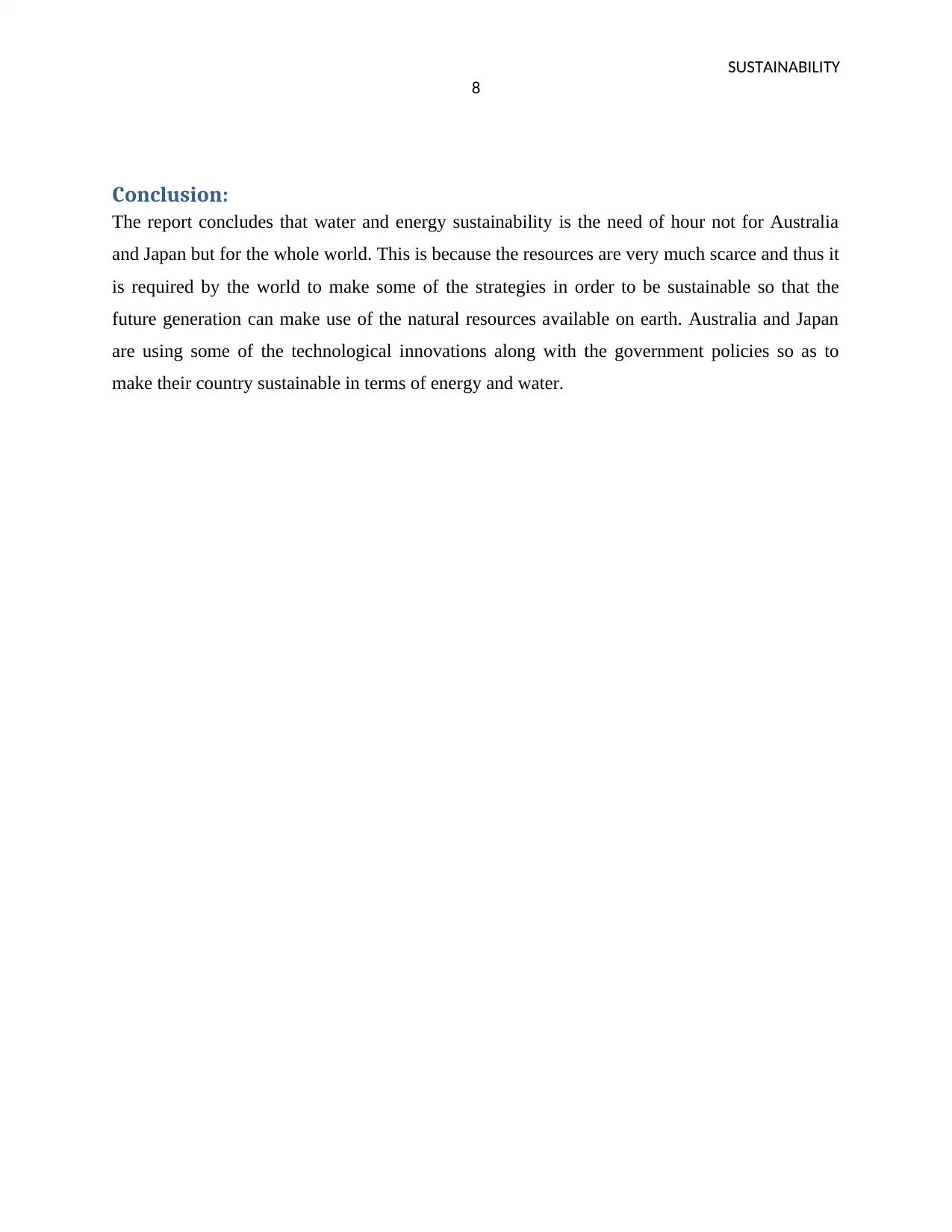
SUSTAINABILITY
8
Conclusion:
The report concludes that water and energy sustainability is the need of hour not for Australia
and Japan but for the whole world. This is because the resources are very much scarce and thus it
is required by the world to make some of the strategies in order to be sustainable so that the
future generation can make use of the natural resources available on earth. Australia and Japan
are using some of the technological innovations along with the government policies so as to
make their country sustainable in terms of energy and water.
8
Conclusion:
The report concludes that water and energy sustainability is the need of hour not for Australia
and Japan but for the whole world. This is because the resources are very much scarce and thus it
is required by the world to make some of the strategies in order to be sustainable so that the
future generation can make use of the natural resources available on earth. Australia and Japan
are using some of the technological innovations along with the government policies so as to
make their country sustainable in terms of energy and water.
⊘ This is a preview!⊘
Do you want full access?
Subscribe today to unlock all pages.

Trusted by 1+ million students worldwide
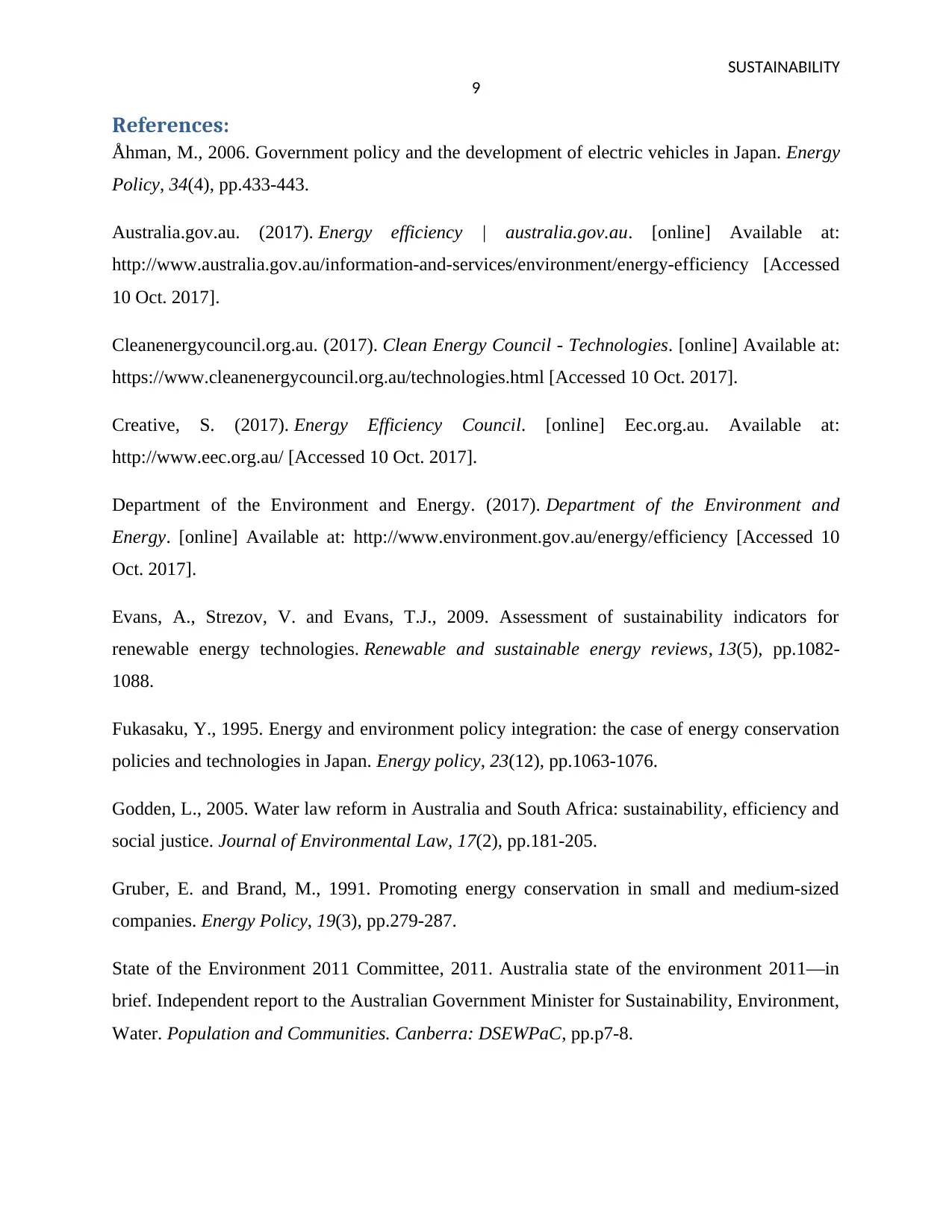
SUSTAINABILITY
9
References:
Åhman, M., 2006. Government policy and the development of electric vehicles in Japan. Energy
Policy, 34(4), pp.433-443.
Australia.gov.au. (2017). Energy efficiency | australia.gov.au. [online] Available at:
http://www.australia.gov.au/information-and-services/environment/energy-efficiency [Accessed
10 Oct. 2017].
Cleanenergycouncil.org.au. (2017). Clean Energy Council - Technologies. [online] Available at:
https://www.cleanenergycouncil.org.au/technologies.html [Accessed 10 Oct. 2017].
Creative, S. (2017). Energy Efficiency Council. [online] Eec.org.au. Available at:
http://www.eec.org.au/ [Accessed 10 Oct. 2017].
Department of the Environment and Energy. (2017). Department of the Environment and
Energy. [online] Available at: http://www.environment.gov.au/energy/efficiency [Accessed 10
Oct. 2017].
Evans, A., Strezov, V. and Evans, T.J., 2009. Assessment of sustainability indicators for
renewable energy technologies. Renewable and sustainable energy reviews, 13(5), pp.1082-
1088.
Fukasaku, Y., 1995. Energy and environment policy integration: the case of energy conservation
policies and technologies in Japan. Energy policy, 23(12), pp.1063-1076.
Godden, L., 2005. Water law reform in Australia and South Africa: sustainability, efficiency and
social justice. Journal of Environmental Law, 17(2), pp.181-205.
Gruber, E. and Brand, M., 1991. Promoting energy conservation in small and medium-sized
companies. Energy Policy, 19(3), pp.279-287.
State of the Environment 2011 Committee, 2011. Australia state of the environment 2011—in
brief. Independent report to the Australian Government Minister for Sustainability, Environment,
Water. Population and Communities. Canberra: DSEWPaC, pp.p7-8.
9
References:
Åhman, M., 2006. Government policy and the development of electric vehicles in Japan. Energy
Policy, 34(4), pp.433-443.
Australia.gov.au. (2017). Energy efficiency | australia.gov.au. [online] Available at:
http://www.australia.gov.au/information-and-services/environment/energy-efficiency [Accessed
10 Oct. 2017].
Cleanenergycouncil.org.au. (2017). Clean Energy Council - Technologies. [online] Available at:
https://www.cleanenergycouncil.org.au/technologies.html [Accessed 10 Oct. 2017].
Creative, S. (2017). Energy Efficiency Council. [online] Eec.org.au. Available at:
http://www.eec.org.au/ [Accessed 10 Oct. 2017].
Department of the Environment and Energy. (2017). Department of the Environment and
Energy. [online] Available at: http://www.environment.gov.au/energy/efficiency [Accessed 10
Oct. 2017].
Evans, A., Strezov, V. and Evans, T.J., 2009. Assessment of sustainability indicators for
renewable energy technologies. Renewable and sustainable energy reviews, 13(5), pp.1082-
1088.
Fukasaku, Y., 1995. Energy and environment policy integration: the case of energy conservation
policies and technologies in Japan. Energy policy, 23(12), pp.1063-1076.
Godden, L., 2005. Water law reform in Australia and South Africa: sustainability, efficiency and
social justice. Journal of Environmental Law, 17(2), pp.181-205.
Gruber, E. and Brand, M., 1991. Promoting energy conservation in small and medium-sized
companies. Energy Policy, 19(3), pp.279-287.
State of the Environment 2011 Committee, 2011. Australia state of the environment 2011—in
brief. Independent report to the Australian Government Minister for Sustainability, Environment,
Water. Population and Communities. Canberra: DSEWPaC, pp.p7-8.
1 out of 10
Related Documents
Your All-in-One AI-Powered Toolkit for Academic Success.
+13062052269
info@desklib.com
Available 24*7 on WhatsApp / Email
![[object Object]](/_next/static/media/star-bottom.7253800d.svg)
Unlock your academic potential
Copyright © 2020–2025 A2Z Services. All Rights Reserved. Developed and managed by ZUCOL.





